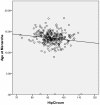Age at menarche in relation to nutritional status and critical life events among rural and urban secondary school girls in post-conflict northern Uganda
- PMID: 24885913
- PMCID: PMC4021025
- DOI: 10.1186/1472-6874-14-66
Age at menarche in relation to nutritional status and critical life events among rural and urban secondary school girls in post-conflict northern Uganda
Abstract
Background: Menarche age is an important indicator of reproductive health of a woman or a community. In industrial societies, age at menarche has been declining over the last 150 years with a secular trend, and similar trends have been reported in some developing countries. Menarche age is affected by genetic and environmental cues, including nutrition. The study was designed to determine the age at menarche and its relation to childhood critical life events and nutritional status in post-conflict northern Uganda.
Methods: This was a comparative cross-sectional study of rural and urban secondary school girls in northern Uganda. Structured questionnaires were administered to 274 secondary school girls, aged 12 - 18 years to determine the age at menarche in relation to home location, nutritional status, body composition and critical life events.
Results: The mean age at menarche was 13.6 ± 1.3 for rural and 13.3 ± 1.4 years for urban dwelling girls (t = -1.996, p = 0.047). Among the body composition measures, hip circumference was negatively correlated with the age at menarche (r = -0.109, p = 0.036), whereas height, BMI and waist circumference did not correlate with menarche. Paternal (but not maternal) education was associated with earlier menarche (F = 2.959, p = 0.033). Childhood critical life events were not associated with age at menarche.
Conclusions: Age at menarche differed among urban and rural dwelling school girls and dependent on current nutritional status, as manifested by the hip circumference. It was not associated with extreme stressful childhood critical life events.
Figures
Similar articles
-
Association between BMI and age at menarche or spermarche among both sexes: Findings from six successive national surveys in China.J Glob Health. 2024 May 10;14:04099. doi: 10.7189/jogh.14.04099. J Glob Health. 2024. PMID: 38726560 Free PMC article.
-
Age at menarche among school girls in Sokoto, Northern Nigeria.Ann Afr Med. 2012 Apr-Jun;11(2):103-7. doi: 10.4103/1596-3519.93533. Ann Afr Med. 2012. PMID: 22406670
-
Urban-rural disparities in the nutritional status of school adolescent girls in the Mizan district, south-western Ethiopia.Rural Remote Health. 2015 Jul-Sep;15(3):3012. Epub 2015 Jul 30. Rural Remote Health. 2015. PMID: 26235698
-
Urban Rural Comparison of Anthropometry and Menarcheal Status of Adolescent School Going Girls of Jodhpur, Rajasthan, India.J Clin Diagn Res. 2016 Oct;10(10):SC08-SC12. doi: 10.7860/JCDR/2016/21882.8757. Epub 2016 Oct 1. J Clin Diagn Res. 2016. PMID: 27891415 Free PMC article.
-
Assessment of the differences in Mean Age at Menarche (MAM) among adolescent girls in rural and urban Nigeria: a systematic review.BMC Public Health. 2024 Dec 18;24(1):3468. doi: 10.1186/s12889-024-21054-y. BMC Public Health. 2024. PMID: 39695506 Free PMC article.
Cited by
-
A Longitudinal Assessment of Associations between Adolescent Environment, Adversity Perception, and Economic Status on Fertility and Age of Menarche.PLoS One. 2016 Jun 1;11(6):e0155883. doi: 10.1371/journal.pone.0155883. eCollection 2016. PLoS One. 2016. PMID: 27249338 Free PMC article.
-
The Changes of Serum Leptin and Kisspeptin Levels in Chinese Children and Adolescents in Different Pubertal Stages.Int J Endocrinol. 2016;2016:6790794. doi: 10.1155/2016/6790794. Epub 2016 Nov 20. Int J Endocrinol. 2016. PMID: 27990162 Free PMC article.
-
The Role of Fetal, Infant, and Childhood Nutrition in the Timing of Sexual Maturation.Nutrients. 2021 Jan 28;13(2):419. doi: 10.3390/nu13020419. Nutrients. 2021. PMID: 33525559 Free PMC article. Review.
-
Obstetric fistulas in Uganda: scoping review using a determinant of health approach to provide a framework for health policy improvement.BMC Pregnancy Childbirth. 2020 Apr 29;20(1):257. doi: 10.1186/s12884-020-02951-7. BMC Pregnancy Childbirth. 2020. PMID: 32349703 Free PMC article.
-
Nakalanga Syndrome: Clinical Characteristics, Potential Causes, and Its Relationship with Recently Described Nodding Syndrome.PLoS Negl Trop Dis. 2017 Feb 9;11(2):e0005201. doi: 10.1371/journal.pntd.0005201. eCollection 2017 Feb. PLoS Negl Trop Dis. 2017. PMID: 28182652 Free PMC article. Review.
References
-
- McDowell MA. Has age at menarche changed? Results from the National Health and Nutrition Examination Survey (NHANES) 1999–2004. Hyattsville, Maryland: CDC; 2007. - PubMed
Publication types
MeSH terms
LinkOut - more resources
Full Text Sources
Other Literature Sources
Medical


